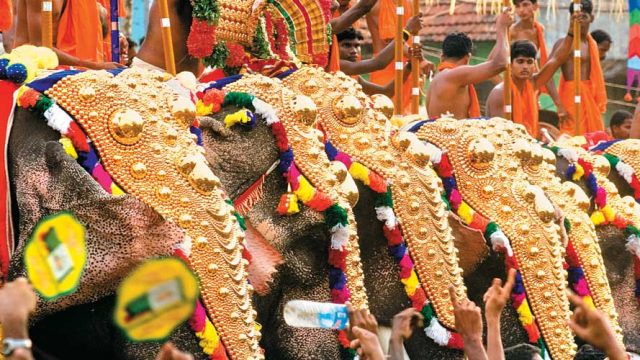The story of the erstwhile princely state of Kochi is not just stranger than fiction, but also colourful and intriguing. Rich and fertile, and central to Kerala in terms of more than just location, Kochi has played a formative role in the evolution of the socio-cultural, economic and political identity of the state.
The heartland of Kerala, Kochi region includes the districts of Ernakulam and Thrissur, and parts of Palakkad. The topography of central Kerala is a reflection of its traditional diversity. The coastal belt includes the historical towns of Kodungallur, North Paravur, Chennamangalam, Kochi and Mattanchery, which is now a part of Kochi. In the fertile terrain between the river systems of the Chalakudi and the Periyar lie the urban, commercial settlements of Kothamangalam, Kakkanad, Kalady and Aluva. The town of Thrissur, on the southern banks of the Bharatapuzha river, offers another variation in the landscape.
Kerala’s political history has been shaped primarily by the sea, which has on the one hand brought in prosperity by way of trade and commerce, and on the other natural disasters in the form of floods that changed the physical and political landscape of the region.
The earliest monarchical polity in Kerala originated under the Perumals, who established the later Chera kingdom at Mahodayapuram near the port of Muziris, now known as Kodungallur. During the first three centuries of the Christian Era, Muziris was the west coast’s entrepôt, and had trade relations with the Arabs, Greeks and Romans. As trade flourished over the following centuries, the region also witnessed the arrival of Christianity, Judaism and Islam.
St. Thomas the Apostle is believed to have arrived in Kerala in the 1st century CE and founded seven (and a half) churches at Kodungallur, Kollam, Niranam, Chayal, Kokkamangalam, Paravoor, Chattukulangara and Thiruvithamcode Arappally. The last of these is sometimes refered to as a “half” church, because it is believed that St. Thomas only established a cross here for 64 Christian families, and the church itself came up later. The Cochin Jews, or Malabar Jews, are said to be the oldest Jewish community in the Indian Subcontinent. The first mosque in the subcontinent was built at Kodungallur in 629 CE, during the lifetime of Prophet Mohammed himself.

Kerala’s traditional cultural pluralism finds greatest expression at Kodungallur, which was the centre of power until the 14th century. After the flood of 1341 CE, the focus of power, commerce and culture shifted from the thriving port of Kodungallur, which was rendered a wasteland of alluvial deposits. The vacuum of commercial and political power was then filled by other trading ports. Over a period of time, as Kodungallur lost its commercial dominance, Kochi became the centre of maritime trade on the western coast of the Indian Subcontinent. Kodungallur remained a hub of cultural activity, home to important literary movements such as the Venmani poets in the 19th century.
The Kingdom of Kochi stretched over a vast region even before the arrival of the Portugese in the 16th century. Its connection with the Indian spice trade, even before the flood of 1341 CE, assured it a unique position in the history of Kerala. Kochi’s waterfront has witnessed a history of innumerable wars fought over trading interests. From prolonged bloody engagements between the Zamorins and the Portuguese, to the conquest of the region by the Mysore ruler Haidar Ali, to decisive Dutch sorties on Portuguese posts and patient British naval manoeuvres that ultimately threw the Dutch out of the Arabian Sea. After independence, Kochi was the first princely state to willingly join the Indian Union. In recent years, the city has witnessed remarkable modernisation and rapid economic development. It remains the commercial centre of Kerala, while its architecture reflects the financial and political affluence of the old Colonial city.

The early urban settlements along the banks of the River Periyar are intricately linked with Kerala’s cultural history. The great Indian philosopher-saint, Adi Shankaracharya was born in Kalady, a small but culturally vibrant town to the east of the Periyar river, in the 8th century CE. Adi Shankaracharya reinterpreted prevailing Vedic knowledge and rejuvenated Hindu religious practice throughout the subcontinent. Many temples associated with this saint can be found at Kalady, each with its own history. Kothamangalam, another important city in the Ernakulam District, is also known for its Syrian churches and finds mention in ancient Tamil texts, pointing to a rich and varied history. It lies in an area known for its forests, teeming with rare birds and animals such as leopards, sloth bears and elephants. The Salim Ali Bird Sanctuary at Thattekad, 13km away from Kothamangalam, is the perfect place for spotting rare birds such as the Ceylon frogmouth, the crimson-throated barbet and the Malabar hornbill.
Another rich cultural hub is Thrissur, sometimes referred to as the Cultural Capital of Kerala. Its extraordinary heritage includes grand temples and shrines, each famous for the yearly festival known locally as the Pooram. The Thrissur Pooram finds its roots in the 18th century, when Shakthan Thempuran, Raja of Kochi, brought together ten temples and organised the Thrissur Pooram as a people’s festival. This was an act of political significance, as it took away the impetus of religious activities from corrupt temple-owning nobles. The riotous celebrations are marked with fireworks, the hoisting of flags and ceremonial processions led by caparisoned elephants.




